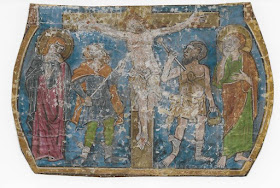On the same page as the most recent blog post about the Brummer photo albums is a manuscript miniature with a very distinctive shape, shown above, with a detail here:
Even without enhancing the image we can see that this must be the leaf that was in the collection of Bernard Breslauer, with the last page of the calendar on the recto and the and beginning of the series of full-page miniatures on the verso; both sides reproduced in colour in the 1992-93 Morgan Library exhibition catalogue:
As an aside, I visited Breslauer once in his apartment overlooking the Metropolitan Museum, and this leaf had pride of place, on a stand in the middle of his dining-table, so that both sides could be seen.
The provenance of the leaf is well known. The parent manuscript is traditionally thought to have perhaps been made for Herman II of Thuringia and his wife Helen c.1238/9. It was in Hildesheim by the 14th century, and later in the collection of the Dukes of Arenberg until sold by Jacques Seligman & Co, Inc., New York, in 1952, to Count Guy de Boisrouvray, who gave it to the BnF, Paris, in 1961, where it is ms. n.a.l. 3102 (an incomplete set of black and white images is available through Gallica). Incidentally, the Seligman archive has been digitized and includes a photograph of the Psalter on display, when it was for sale; this opening with half-length saints forming a border around their names in the litany:
can be seen in the middle of the display-cabinet to the left of this image:
 |
| [detail] |
- Robert Forrer, Strassburg (whom we have encountered in several previous blog posts): included as one of three leaves with full-page miniatures from the Arenberg Psalter in his 1907 catalogue (see below);
- Edouard Kann, Paris (his catalogue by Boinet, 1926, no. 68);
- Wildenstein & Co. (Paul Wescher, Miniaturen ... des Kupferstichkabinetts der Staatlichen Museen Berlin, 1931);
- Ernst Brummer; sold in 1948 to:
- Joel and Maxine Spitz, Glencoe, IL (Supplement to de Ricci's, Census, p. 167 no. 9F); by descent until:
- Sold at Sotheby's, 29 November 1990, lot 6; to:
- Bernard Breslauer (bidding under the name "A. Client").
The Breslauer leaf is one of at least three that were extracted from the parent volume. One other is in the National Gallery of Art, Washington, D.C. (Inv. 1946.21.11):
On the back is the Forrer ink-stamp, here partly hidden by the mount:
It is not in his 1902 catalogue, but it is in his 1907 catalogue:
This gives us a good idea of when he acquired it, and in fact we can narrow the date-range of his acquisition even further, because he wrote about them in the Strassburger Post on 20 September 1904.
Another leaf with a foliate initial "D" is in Berlin, and a third, with a full-page miniature of the Flagellation and Crucifixion, is in the Art Institute, Chicago:
 |
| [source] |
 |
| [detail] |
It is presumably a modern copy, painted on a leaf from real medieval manuscript:
The Brummer Archive stock card shows that they believed it to be 13th-century Italian; they bought it from Seligman in 1927 for $39, and sold it to Mrs Walter Baker in 1942 for $125.















No comments:
Post a Comment
** PLEASE INCLUDE YOUR NAME IN YOUR COMMENT **
I may ignore and delete anonymous comments